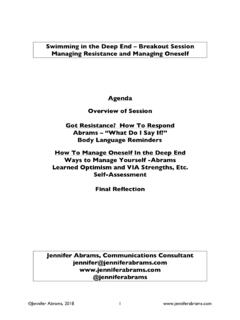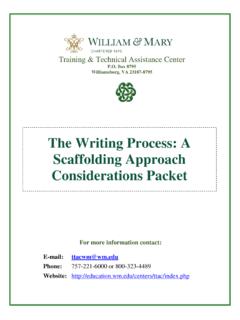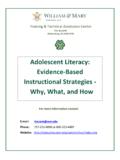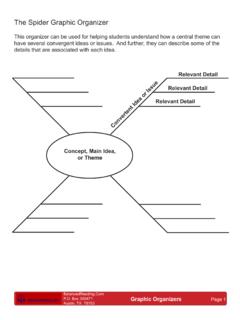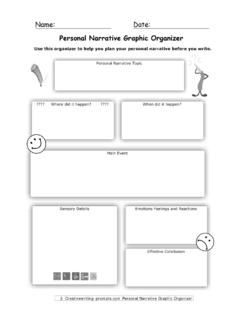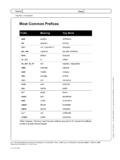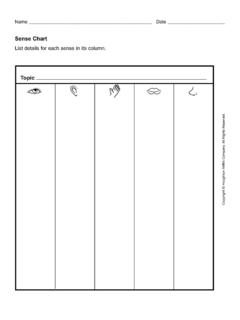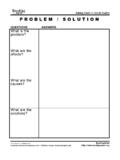Transcription of Training & Technical Assistance Center
1 Training & Technical Assistance Center Box 8795 Williamsburg, VA 23187-8795 Graphic Organizers: Guiding Principles and Effective Practices Considerations Packet For more information contact: E-mail: Phone: 757-221-6000 or 800-323-4489 Website: Considerations: Graphic Organizers: Guiding Principles and Effective Practices T/TAC W&M Updated 2015 2 Graphic Organizers: Guiding Principles and Effective Practices This T/TAC W&M Considerations Packet focuses on how to make the most out of graphic organizers for instruction. Visual displays and representations of information, commonly called graphic organizers, have become standard practice in most educational settings.
2 But simply using a graphic organizer does not guarantee enhanced student understanding or achievement. Research and best practices have shown that, for graphic organizers to be effective instructional tools, several factors must be addressed. First, the graphic organizers need to very straightforward and coherent. Next, students must be taught how to use the graphic organizer. Finally, teachers should consistently use graphic organizers during all aspects of instruction so that students begin to internalize the organizational skills of the graphic display. This Considerations Packet will present strategies and approaches for incorporating these elements, along with outlining the primary categories and uses for graphic organizers.
3 The Basics of Graphic Organizers Graphic organizers are visual displays of key content information designed to benefit learners who have difficulty organizing information (Fisher & Schumaker, 1995). Sometimes referred to as concept maps, cognitive maps, or content webs, no matter what name is used, the purpose is the same: Graphic organizers are meant to help students clearly visualize how ideas are organized within a text or surrounding a concept. Through use of graphic organizers, students have a structure for abstract ideas. Graphic organizers can be categorized in many ways according to the way they arrange information: hierarchical, conceptual, sequential, or cyclical (Bromley, Irwin-DeVitis, & Modlo, 1995).
4 Some graphic organizers focus on one particular content area. For example, a vast number of graphic organizers have been created solely around reading and prereading strategies (Merkley & Jeffries, 2000). Before presenting an overview of different types and uses of graphic organizers, some guiding principles to keep in mind when using them in the classroom are offered below. Guiding Principles for Using Graphic Organizers Keep Them Simple For graphic organizers to be effective instructional tools, they must be clear and straightforward (Boyle & Yeager, 1997; Egan, 1999). The connections and relationships between the ideas depicted in the organizer should be obvious, otherwise the academic benefits will be limited.
5 If an organizer is poorly constructed, includes too much information, or contains distractions, students can easily become confused and even more disorganized than before in their understanding of the target concepts (Robinson, 1998). Therefore, teachers must keep graphic organizers simple. Suggestions for following this principle include: Limit the number of ideas covered in each organizer. Focus on essential concepts that students need to understand and remember. Include clear labels and arrows to identify the relationships between concepts. Considerations: Graphic Organizers: Guiding Principles and Effective Practices T/TAC W&M Updated 2015 3 Be careful of graphic organizers that accompany teacher resource materials.
6 They often contain many pictures or background visuals that are distracting to students. Teach to and with the Organizer As with all instructional tools, students need to be taught how to use graphic organizers effectively and efficiently. Students enter the classroom with varied experiences using graphic organizers. Therefore, teachers must give explicit instructions about how to organize information and when a particular organizer is beneficial. With such guidance and scaffolding, students gain greater independence with graphic organizers. Once students understand how to use an organizer, teachers need to implement it in creative and engaging ways to enhance effectiveness (Bromley et al.)
7 , 1995). As organizers have become more common, simply using an organizer is no longer enough to maintain students attention and focus. The following ideas will help ensure that students are engaged with organizers. Allow students to add illustrations. As long as the pictures add to a student s understanding of the concepts displayed and do not distract, illustrations can be very engaging. Implement organizers with cooperative groups or pairs of students. Organizers can be excellent tools for discussion and student engagement with each other. Allow students to make their own organizers and share them with the class.
8 As students become more comfortable using organizers, they can teach the strategies they use to organize information for the whole group. Use Graphic Organizers Often Many students benefit from routine and structure, so using graphic organizers consistently in the classroom will help them internalize the organizing techniques that are being taught (Griffin & Tulbert, 1995). The more students are exposed to organizers, the more familiar and comfortable they will become using them. Here are some things to consider when trying to be consistent: Establish a routine for using organizers during instruction. For example, always use a web when starting a new unit, no matter what the subject area is.
9 Use the same sequence chart when ordering events or steps in math, reading, writing, science, or social studies. Incorporate organizers into all phases of instruction. When students see them used as a warm-up, a guided practice, or a homework assignment, they better understand the purpose and the benefits of the organizer. If students have difficulty using a particular organizer, don t give up. Students will often struggle with new approaches. Stay consistent and keep providing them guidance and practice. When students see the teacher using an organizer consistently, they are more likely to understand it themselves.
10 Considerations: Graphic Organizers: Guiding Principles and Effective Practices T/TAC W&M Updated 2015 4 Types of Graphic Organizers With these guiding principles in mind, we will now present some of the most common graphic organizers used by teachers and considerations for using them in the classroom. Concept Map A concept map is a general organizer that shows a central idea with its corresponding characteristics. Concept maps can take many different shapes and can be used to show any type of relationship that can be labeled. Maps are excellent resources for (a) brainstorming at the beginning of a chapter in any content area, (b) activating prior knowledge before reading a story, or (c) coming up with synonyms.



